Leukemia is a complex blood cancer that can be hard to understand. As a professional writer, I aim to make this guide clear and helpful. It covers everything from what leukemia is and its types to the newest treatments and care options. This guide is for you or your loved one facing leukemia, offering key info to help you make good choices and face challenges.
Key Takeaways
- Leukemia is a type of blood cancer that affects the production and function of blood cells.
- There are several different types of leukemia, each with its own characteristics and treatment approaches.
- Symptoms of leukemia can vary and may include fatigue, frequent infections, easy bruising, and unexplained weight loss.
- Risk factors for leukemia include genetic predisposition, environmental factors, and certain medical conditions.
- Diagnosis and staging of leukemia involve various diagnostic tests, including blood tests, bone marrow biopsies, and imaging scans.
What is Leukemia?
Leukemia is a serious blood cancer that starts in the bone marrow. This is where our blood cells are made. It happens when abnormal white blood cells grow too fast and crowd out the healthy ones. This can make it hard for our body to fight off infections.
Definition and Overview
Leukemia is a group of hematological cancers that cause too many immature or bad white blood cells. These cells can harm the production and function of other blood cells. This leads to health problems.
Types of Leukemia
There are several types of leukemia, each with its own way of treating it:
- Acute Lymphocytic Leukemia (ALL)
- Acute Myeloid Leukemia (AML)
- Chronic Lymphocytic Leukemia (CLL)
- Chronic Myeloid Leukemia (CML)
These leukemias are classified by the cell type and how fast they grow. This helps doctors decide on the best treatment.
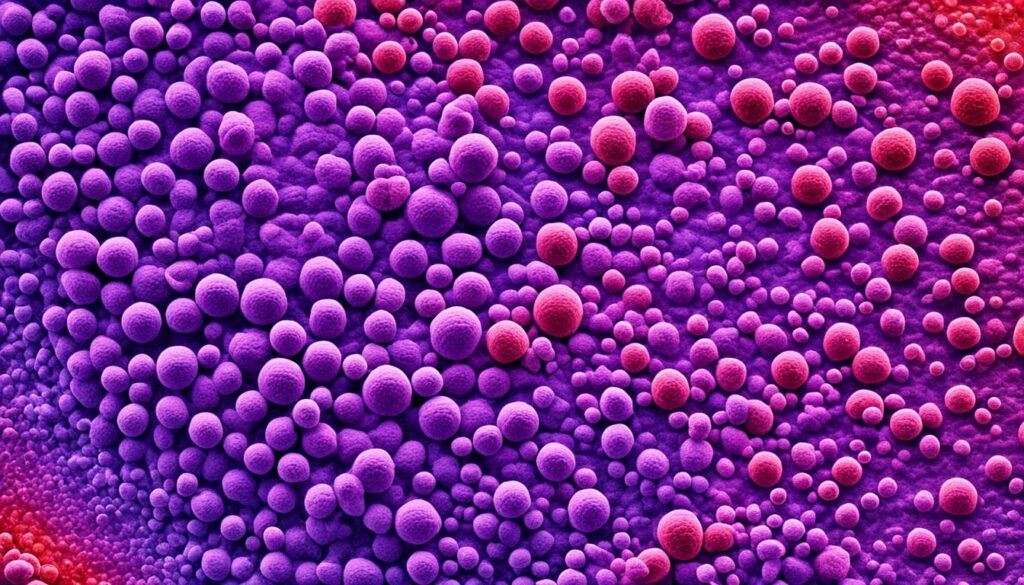
“Leukemia is a complex and multifaceted disease, but with advancements in research and treatment, there is hope for patients and their families.”
| Type of Leukemia | Description | Prognosis |
|---|---|---|
| Acute Lymphocytic Leukemia (ALL) | Involves the rapid growth of immature lymphocytes (a type of white blood cell) | Varies, but generally has a good prognosis with appropriate treatment |
| Acute Myeloid Leukemia (AML) | Involves the rapid growth of immature myeloid cells (a type of white blood cell) | Prognosis can vary significantly, depending on the subtype and patient factors |
| Chronic Lymphocytic Leukemia (CLL) | Involves the slow growth of mature lymphocytes (a type of white blood cell) | Prognosis can be quite good, with many patients living for years with proper management |
| Chronic Myeloid Leukemia (CML) | Involves the slow growth of mature myeloid cells (a type of white blood cell) | Prognosis has improved significantly with the advent of targeted therapies |
Leukemia Symptoms, Treatments, and Hematology
Dealing with leukemia can feel overwhelming, but knowing the symptoms and treatments is key. Leukemia is a blood cancer that shows in different ways. Symptoms include feeling very tired, getting sick often, bleeding easily, and losing weight without trying.
How to treat leukemia depends on the type and stage of the disease. Doctors might use chemotherapy, radiation, targeted therapies, or bone marrow/stem cell transplants. These are some ways to fight the disease, chosen by blood cancer experts.
| Common Leukemia Symptoms | Leukemia Treatment Options |
|---|---|
|
|
Hematologists are key in finding and treating leukemia. They use their knowledge to help patients and their families. They create treatment plans that fit each person’s needs and challenges.
“Leukemia is a complex disease, but with the right medical team and treatment plan, patients can navigate this journey with hope and resilience.”
Research is always improving leukemia treatments, offering new hopes for recovery. By staying informed and working with their doctors, people with leukemia can take charge of their health. This helps them live better.

Risk Factors and Causes
The exact causes of leukemia are still a mystery, but researchers have found some key risk factors. Genetic predisposition is a big one. If you have a family member with leukemia, like a parent or sibling, you might be more likely to get it too. This is because you share genes with them.
Other than genes, environmental factors also play a role. Things like certain chemicals, radiation, and smoking can raise your risk of getting leukemia. For example, being around a lot of benzene, a chemical found in some workplaces, can increase your chance of getting acute myeloid leukemia (AML).
- Genetic predisposition: Having a close family member with leukemia can increase the risk of developing the disease.
- Environmental factors: Exposure to chemicals, radiation, and smoking can contribute to the development of leukemia.
- Benzene exposure: High levels of exposure to this chemical have been linked to an increased risk of acute myeloid leukemia (AML).

It’s important to understand how genes and the environment affect each other to find people at higher risk. By knowing these risk factors, doctors and patients can work together. This can help lower the risk of leukemia and improve health outcomes.
Diagnosis and Staging
Diagnosing leukemia is key to finding the right treatment. It starts with detailed blood tests to check blood cell counts. Then, a bone marrow biopsy looks at cells in the bone marrow.
Blood tests are vital to spot blood cell issues. They help figure out the leukemia type and stage.
The bone marrow biopsy is a deeper look into the bone marrow. It takes a small bone marrow sample for a microscope check. This shows how much and what kind of leukemia is there.
After finding out you have leukemia, the next step is staging. Leukemia staging shows how far the disease has spread. It uses tests like imaging scans to see how much cancer is there.
With all these tests, doctors get a full picture of the leukemia. They can then make a treatment plan just for you, based on your specific situation.
Acute Lymphocytic Leukemia
Acute lymphocytic leukemia (ALL) is a fast-growing blood cancer that starts in the lymphoid cells. These cells are a type of white blood cell. It’s crucial to diagnose and treat this cancer quickly to help patients.
Recognizing the Symptoms of Acute Lymphocytic Leukemia
ALL’s early signs can be similar to common health problems. Patients might feel feverish, tired, bruise easily, and get sick often. They may also notice swollen lymph nodes, pain in bones or joints, and lose weight without a clear reason.
Diagnosing and Treating Acute Lymphocytic Leukemia
To diagnose ALL, doctors do blood tests, bone marrow aspiration, and biopsies. After finding out you have ALL, treatment usually includes strong chemotherapy. This helps kill cancer cells and get you into remission. Sometimes, a bone marrow transplant or stem cell transplant is also suggested.
| Treatment Option | Description |
|---|---|
| Chemotherapy | Intensive chemotherapy regimens to eliminate the cancerous cells and achieve remission. |
| Bone Marrow Transplant | A procedure that replaces damaged or destroyed bone marrow with healthy stem cells, often from a donor. |
| Stem Cell Transplant | A treatment that uses high-dose chemotherapy or radiation to destroy the patient’s cancerous cells, followed by the infusion of healthy stem cells to rebuild the immune system. |
Treating ALL is complex and ongoing. The main goal is to get into remission and improve life quality. Regular check-ups are key to making sure the treatment is working well.

“Acute lymphocytic leukemia is a highly treatable form of cancer, with many patients achieving long-term remission and excellent outcomes.”
Acute Myeloid Leukemia
Acute myeloid leukemia (AML) is a serious and fast-moving blood cancer. It targets the myeloid cells, which make blood components like red cells, white cells, and platelets. AML needs quick and detailed treatment.
Chemotherapy is a key treatment for AML. It uses strong drugs to kill cancer cells and help make healthy cells again. But, chemotherapy can have tough side effects, so it’s vital to have close doctor care and support during treatment.
Sometimes, targeted therapies are used with or instead of chemotherapy. These treatments focus on certain genetic changes or pathways in AML cells. This can offer less harsh options for patients. Research and trials are always looking into new ways to treat AML.
Handling AML can feel overwhelming, but a team of doctors and the latest in leukemia treatments can help. Patients can make better choices and take charge of their care by understanding AML and its treatments.
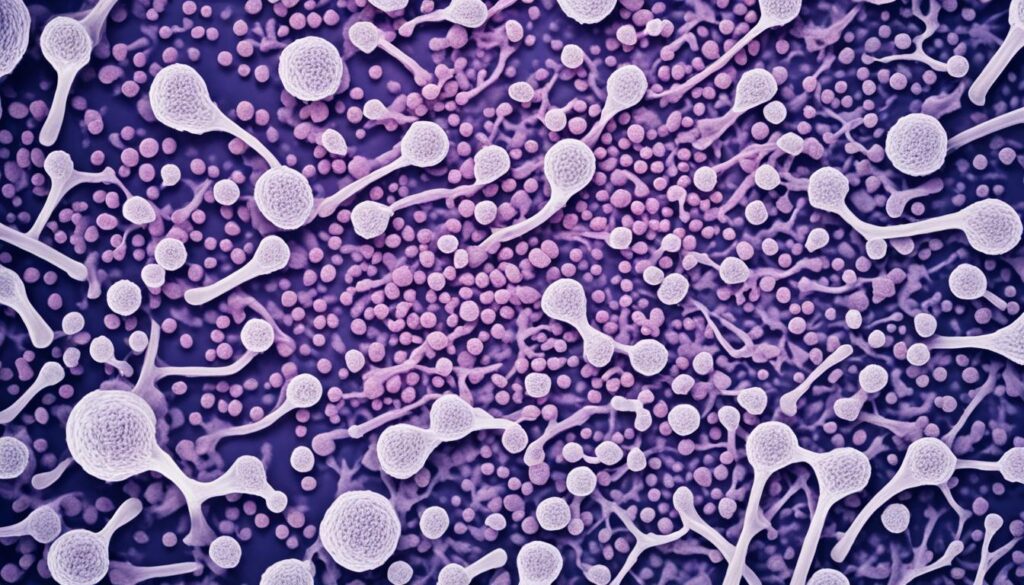
“The key to managing acute myeloid leukemia is to act quickly and decisively, while also prioritizing the patient’s overall well-being and quality of life.”
The treatment for acute myeloid leukemia is always changing. It’s important for patients and their families to keep up with new info, talk with their healthcare team, and look into all options for the best results.
Chronic Lymphocytic Leukemia
Chronic lymphocytic leukemia (CLL) is a slow-growing blood cancer that mainly affects older people. It grows slowly, needing a careful approach to manage it. Knowing how the disease progresses and the treatment options is key for patients and their care.
Progression and Monitoring
CLL’s progress can vary, with some patients seeing slow growth and others a faster spread. Regular blood tests and check-ups help doctors keep an eye on the disease. This lets them decide when and what treatment is best.
Treatment Strategies
Handling CLL has changed a lot, thanks to new treatments like targeted therapies and better chemotherapy. Ibrutinib, venetoclax, and acalabrutinib are some of these new treatments that help control the cancer. Sometimes, combining these with chemotherapy works best.
For those with more severe CLL, a stem cell transplant might be an option. This complex process uses healthy stem cells to replace the patient’s bad blood and immune cells. It could lead to long-term remission or even a cure.
Dealing with CLL often means a team of doctors from different fields work together. This team includes oncologists, hematologists, and experts in supportive care. They create treatment plans that fit each patient’s needs, aiming for the best results.
“The management of chronic lymphocytic leukemia has evolved significantly in recent years, with the introduction of targeted therapies and advancements in chemotherapy regimens.”
Chronic Myeloid Leukemia
Chronic myeloid leukemia (CML) affects the myeloid cells in the blood. Over the years, treatment has made great strides. Thanks to targeted therapies, especially tyrosine kinase inhibitors (TKIs), CML is now often a chronic condition.
Targeted Therapies: A New Era in CML Treatment
Before, CML was treated with chemotherapy, which had harsh side effects. But TKIs like imatinib, dasatinib, and nilotinib have changed that. These drugs target the BCR-ABL protein, key to CML, without harming healthy cells. Now, CML patients have better and safer treatment options.
| Tyrosine Kinase Inhibitor | Mechanism of Action | Key Benefits |
|---|---|---|
| Imatinib | Inhibits the BCR-ABL protein | Improved long-term survival, well-tolerated |
| Dasatinib | Inhibits multiple tyrosine kinases, including BCR-ABL | Effective in patients resistant to imatinib, improved response rates |
| Nilotinib | Selective and potent inhibitor of BCR-ABL | Faster and deeper response rates, fewer side effects compared to imatinib |
Targeted therapies have greatly improved the outlook for chronic myeloid leukemia patients. They’ve also made life better by reducing the harsh effects of leukemia treatments. The ongoing development of new targeted therapies and tyrosine kinase inhibitors promises more progress in fighting this blood cancer.
“The advent of targeted therapies has transformed chronic myeloid leukemia from a once-fatal disease into a chronic, manageable condition for many patients.”

Chemotherapy for Leukemia
Leukemia is a tough diagnosis, but thanks to leukemia treatments, there’s hope. Chemotherapy is a key part of fighting this disease.
Chemotherapy uses strong drugs to target and kill cancer cells. It’s effective but can cause side effects. These effects need careful handling by doctors.
Common chemotherapy side effects include:
- Nausea and vomiting
- Fatigue and weakness
- Increased risk of infection
- Bleeding and bruising
- Hair loss (alopecia)
- Mouth sores
To lessen these side effects, doctors give supportive drugs. They also help boost the immune system and manage symptoms. Keeping in touch with the care team is key to handling chemotherapy.
“Chemotherapy may be tough, but it’s a powerful tool in the fight against leukemia. With the right support and management, patients can overcome the challenges and focus on their recovery.”
Even with side effects, chemotherapy is crucial for treating leukemia. By understanding it and working with doctors, patients can get through this tough part. This helps them move towards remission and a better life.
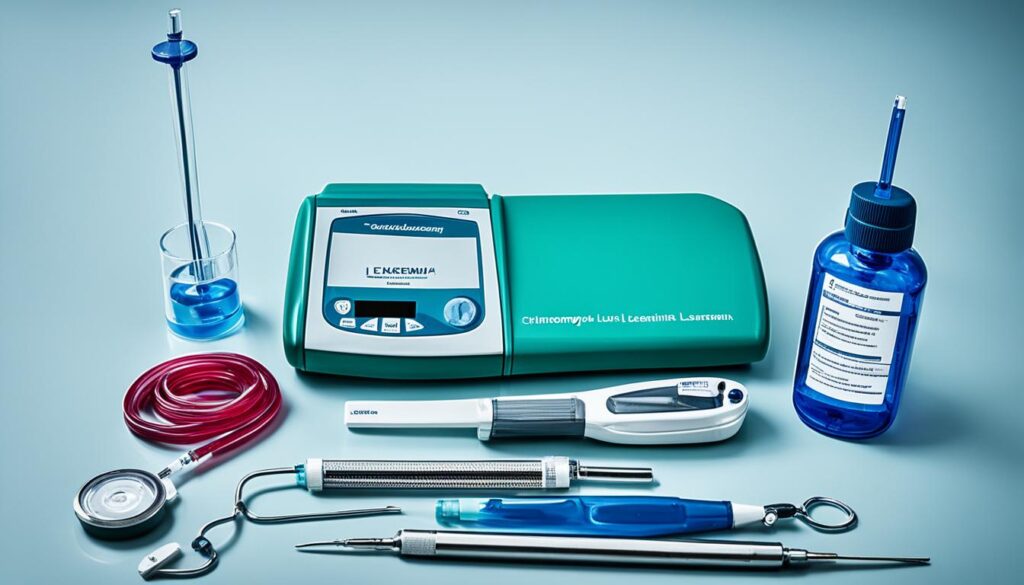
Radiation Therapy
For many fighting leukemia, radiation therapy is a key part of their treatment. This targeted cancer treatment is effective but comes with side effects. It’s vital to know these effects and how to handle them with supportive care.
Managing the Side Effects of Radiation Therapy
Radiation therapy for leukemia can cause fatigue, skin changes, and a higher chance of infection. These effects can be tough, but the right care can help patients feel better and stay well.
- Fatigue: Radiation therapy can make you very tired. It’s key to rest a lot and do gentle exercises when you can.
- Skin changes: The treated skin may turn red, dry, or feel sensitive. Using gentle moisturizers and protecting it from the sun is important.
- Infection risk: Radiation can weaken your immune system, making infections more likely. You might need to avoid crowded places and keep clean.
Handling these side effects well is key for leukemia patients on radiation therapy. Working with their healthcare team helps patients get through these tough times and recover better.
| Side Effect | Management Strategies |
|---|---|
| Fatigue |
|
| Skin Changes |
|
| Infection Risk |
|
Knowing the side effects of radiation therapy and how to manage them helps leukemia patients feel more in control. This way, they can focus on their health and well-being during treatment.

“Radiation therapy can be a powerful tool in the fight against leukemia, but it’s crucial to manage the side effects to ensure the best possible outcome for the patient.”
Bone Marrow Transplant
When standard treatments for leukemia don’t work, a bone marrow transplant can be a lifesaver. This complex procedure replaces damaged bone marrow with healthy stem cells. This can lead to a new, healthy blood system and a chance to recover.
Bone marrow transplants work best for certain types of leukemia when other treatments fail. By giving the body new stem cells, it can start making healthy blood cells again. This can lessen the disease’s effects and help patients get better.
The Bone Marrow Transplant Process
The bone marrow transplant process has several steps:
- Stem cell collection: Healthy stem cells are taken from the patient’s bone marrow, blood, or a donor.
- Conditioning therapy: The patient gets high-dose chemotherapy and/or radiation to destroy the old, damaged bone marrow.
- Stem cell infusion: The stem cells are put into the patient’s bloodstream. They go to the bone marrow and start to grow.
- Recovery: With time, the new stem cells make a healthy blood and immune system. The patient gets stronger and feels better.
The bone marrow transplant journey is tough, but it’s a big chance for people with leukemia. It can help them beat the limits of usual leukemia treatments and get their health back.
| Procedure | Success Rate | Potential Risks |
|---|---|---|
| Bone marrow transplant | 60-80% for certain leukemia types | Infection, bleeding, graft-versus-host disease |
| Stem cell transplant | 50-70% for certain leukemia types | Organ damage, infertility, secondary cancers |
Bone marrow and stem cell transplants are advanced hematology treatments. They can change the lives of people with leukemia. They offer a fresh start at health and vitality.

“Bone marrow transplantation has the potential to cure certain types of leukemia, providing hope where traditional treatments have fallen short.”
Stem Cell Transplant
Patients with leukemia might get a stem cell transplant. This is a special way to make new bone marrow and blood cells after strong chemotherapy or radiation. It’s a complex process that needs careful watching by hematology experts for the best results.
Procedure and Recovery
The first step is collecting healthy stem cells. These can come from the patient or a donor. Then, these cells are kept safe until it’s time for the transplant.
Before the transplant, the patient gets a special treatment. This includes high-dose chemotherapy and/or radiation. It’s to kill any cancer cells left and make room for the new stem cells.
After that, the stored stem cells are given back to the patient. They start rebuilding the blood and immune system. But, this time can be tough. Patients might feel very tired, sick, or more likely to get infections.
| Stem Cell Transplant | Bone Marrow Transplant |
|---|---|
| Uses stem cells from the blood or bone marrow | Uses stem cells from the bone marrow |
| Less invasive procedure | More invasive procedure |
| Shorter recovery time | Longer recovery time |
| Suitable for a wider range of patients | Suitable for a narrower range of patients |
The hematology team keeps a close eye on the patient’s recovery. They offer support and deal with any problems that come up. With the right care, many patients can get back to their lives.
“Stem cell transplants offer a chance for a new beginning for many leukemia patients, but the process requires immense dedication and resilience from both the medical team and the patient.”
Supportive Care and Quality of Life
Leukemia patients face a tough journey. They deal with the medical side and how it affects their well-being. Supportive care and improving their quality of life are key parts of cancer care.
Managing symptoms is a big part of supportive care. Leukemia can cause fatigue, pain, nausea, and infections. Healthcare providers work hard to ease these symptoms and help patients feel better.
Emotional and psychological support is also crucial. Leukemia can be very stressful and lonely for patients and their families. Counseling, support groups, and mental health professionals help them cope with their feelings.
Helping patients with their daily needs is important too. This includes getting them to appointments, financial help, and connecting them with family and community resources. By removing these barriers, patients can focus on getting better.
The main goal of supportive care for leukemia is to make patients comfortable. It aims to lessen symptoms and keep their quality of life as high as possible during treatment. By combining medical, emotional, and practical support, healthcare teams make sure patients get the care they need.
| Supportive Care Aspect | Objectives |
|---|---|
| Symptom Management | Alleviate debilitating symptoms like fatigue, pain, nausea, and infection |
| Emotional and Psychological Support | Provide counseling, support groups, and access to mental health professionals to navigate the emotional challenges |
| Practical and Social Support | Assist with transportation, financial support, and coordination of family and community resources |
“Supportive care in leukemia is not just about treating the disease, but about caring for the whole person and their loved ones throughout the treatment journey.”
Conclusion
Leukemia is a complex blood cancer that has seen a lot of research and treatment advances. Knowing the different types of leukemia helps patients and their families understand their treatment options. These include chemotherapy, radiation therapy, and stem cell transplants.
Hematology, the study of blood disorders, leads in finding new treatments and care for leukemia patients. Thanks to ongoing medical science progress, we hope for more effective treatments and better outcomes soon.
Dealing with leukemia requires hope and action. By working together, patients, doctors, and the community can support those with blood cancer. We aim for a future where leukemia is well understood and managed effectively.

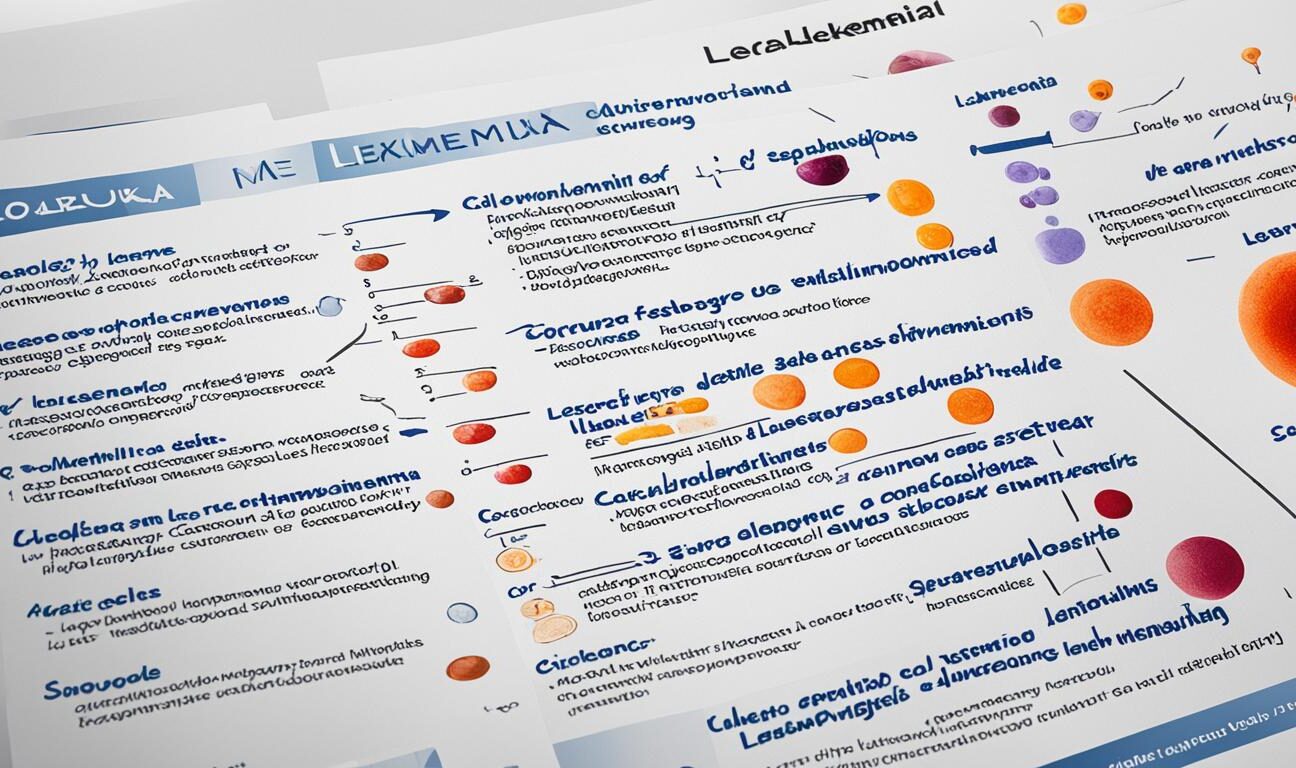


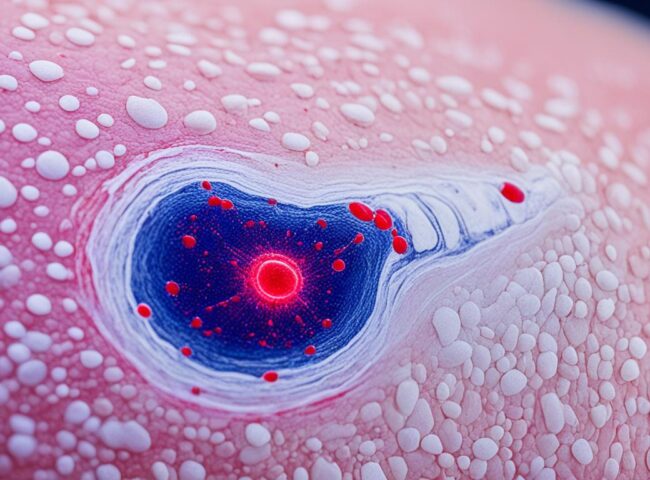


Leave feedback about this